
Ubiquitous, wearable computers have been a dream since at least the 1930s. Chester Gould’s comic strip Dick Tracy introduced the 2-Way Radio Watch worn by members of The City police force. At first merely a combination radio and wristwatch, eventually Tracy’s watch added television and other technical capabilities.
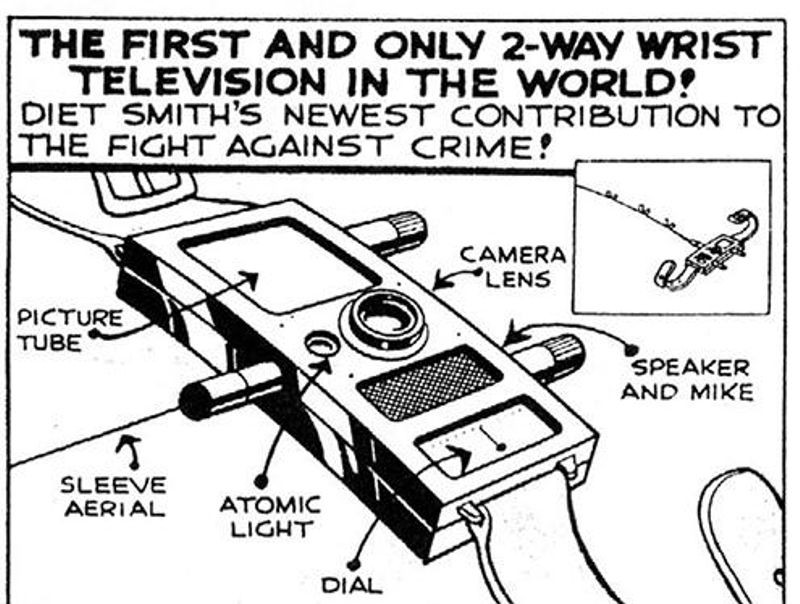
Dick Tracy’s 2-way wrist television also allowed him to communicate with other members of The City’s police force.
This comic strip, in turn, influenced Gene Roddenberry’s communicators on the television series Star Trek, and other images of watch-like communication/computation devices can be found throughout science fiction. The recent announcement of the AppleWatch has renewed interest in computerized wristwatches and revived the idea of a wrist-worn computer that is cool. Of course, the idea is hardly new but it took a long time for the wristwatch computer to reach levels that Dick Tracy achieved.
The earliest combination of the watch form factor with a computational device dates from late 19th century. English company Boucher’s received a patent for a circular slide rule in a pocket watch shape in 1876. French company Meyrat & Perdrizet made a slide rule chronograph in 1890. The central portion of the device was a standard pocket watch face, with a circular slide rule with an independent hand surrounded it. Two dials at the top of the watch allowed it to perform calculations. Several Swiss manufacturers used the same form factor, typically not including an actual watch. The Mechanical Engineer Pocket Calculator was Swiss-made and sold by The Scientific Publishing Company. An early ad for the device noted the special features:
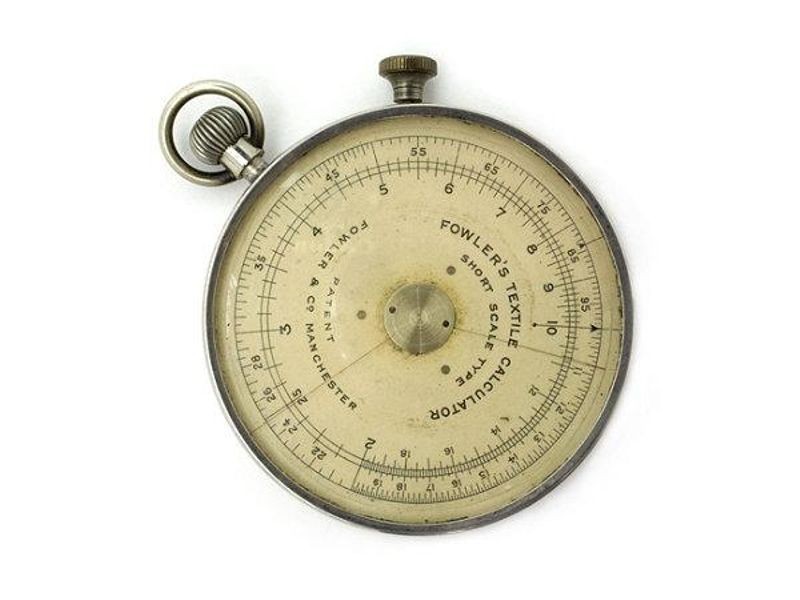
Fowler’s Textile Calculator allowed tailors and weavers to make quick calculations.
English manufacturer Fowler & Company of Manchester made the most significant series of these pocket slide rules. Not only did Fowler sell general-purpose circular slide rules, but also some made to calculate equations specific to areas such as forestry and textiles. One of the major linear slide rule manufacturers, Keuffel & Esser, also created a Pocket Calculator in the same format, though with two separate scales: one on the front of the device, and one on the back.
Wristwatches first appeared at the start of the twentieth century and became the most popular style of watch ever made. Technologies such as the self-winding mechanism and quartz movement, improved manufacturing techniques, and increased popularity in sales to women.
As microelectronics became practical, several companies began experimenting with creating Light-emitting Diode (LED) displays for wristwatches. Hamilton Watch Company sold an electric watch in the 1950s, and even created a semi-digital prop watch for Stanley Kubrick’s film 2001: A Space Odyssey. Hamilton introduced the Pulsar watch on The Johnny Carson Show in 1970, calling it a “Wrist Computer.” The watch featured a red LED display, and required the wearer to press a button to display the time, a step necessary to extend battery life. The 18 karat gold watch sold for $2,100 dollars, making it too expensive for most people. Early versions were also unreliable and complex to manufacture, using 44 chips and more than four thousand bonding wires.

An early Microma LCD Watch
Intel released the first true system-on-a-chip watch, the Microma, in 1974. The Microma used a 5810 microcontroller, which Intel CEO Gordon Moore had hoped would allow for the addition of calculator and calendaring options. Costing $600, it was too expensive for wide adoption. Moore wore a Microma watch for many years, saying that it was a reminder of the 15 million dollar failure of the watch project. Other semiconductor manufacturers entered the watch business, including Fairchild, National Semiconductor, Mostek, and Litronix.
The liquid crystal display (LCD) was a major breakthrough in digital watch technology. More efficient than LED displays, though harder to see in bright rooms or direct sunlight, LCDs proved far more popular with the public. Seiko introduced a LCD watch in 1973, and many other companies followed suit. Texas Instruments’ introduced a plastic-bodied LCD watch for less than twenty dollars that led to an explosion in digital watch sales. Companies like Timex and Seiko produced many models of inexpensive LCD-based watches, while traditional watchmakers such as Longines, Gruen, and Tissot offered high-end digital watches, often incorporating a digital display along with a traditional analog watch face.
The combination of wristwatch and calculator was fast on the heels of the first digital watches. Pulsar introduced an LED-based calculator watch as early as 1975. Hewlett Packard, the world’s leading handheld calculator manufacturer, introduced the HP-01 Wrist Instrument in 1977. The HP-01 used an LED display and sold for more than $600. The watch featured 28 buttons that could only be pressed with a stylus. The high price tag and tiny buttons were not the only problems, as the entire device weighed nearly one pound, quite a burden for the average wrist.
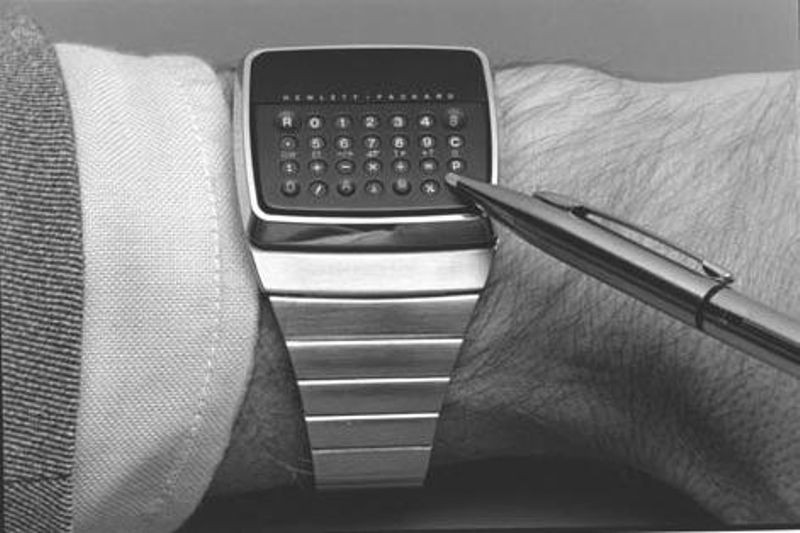
The HP-01 Wrist Instrument required a stylus to press the tiny keys
Innovations in microelectronics led to greater integration of new technologies into wristwatches. Seiko, having purchased Hamilton Watch Company in 1978, introduced an LCD Pulsar wristwatch with television tuner in 1983, as well as a voice recording watch. These were much larger and clumsier than the plastic-bodied wristwatches that were popular at the time, not to mention far more expensive.The technologies used in Dick Tracy were finally available in wristwatches, but you would have to wear more than one to have all the capabilities at the same time!
Japanese electronics company Casio introduced the Databank series of calculator watches in 1983. The line proved successful, especially with students who would often find innovative ways to cheat on tests using them. The company Nelsonic introduced several watches that allowed the wearer to play various games. Nelsonic licensed various properties from game companies such as Nintendo and Midway for their game watches. These were made through the 1990s, when widely available handheld gaming systems like the GameBoy killed off the single game device market.
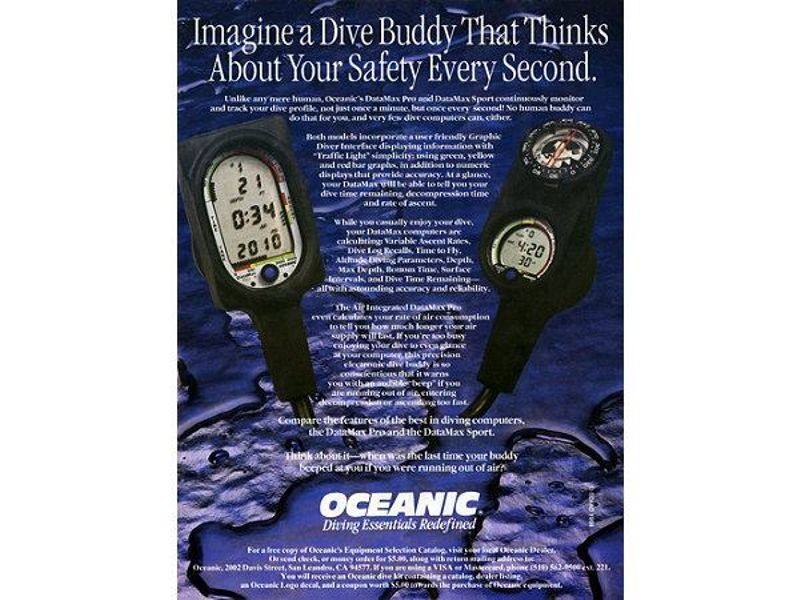
Electronic dive watches allowed for more accurate measurement of depth and time spent below the surface.
The idea of a watch that could interface with a computer dates from 1984, when Seiko released the RC-100 watch that was compatible with most major personal computers. A year later, the RC-20 was introduced as a joint effort between Casio and Epson. The RC-20 Wrist Computer could be used to take memos, display world time, and had a four function calculator. With only 2K of memory, the RC-20 was severely limited in usability. Advances in storage, processing, and monitoring technologies allowed wristwatches to expand into more specialized uses. Electronic dive watches worn by divers to monitor oxygen levels and depth were introduced in the 1980s. Other specialized digital watches were created for athletes, such as runners, skiers, and rally drivers.
Smartwatches began to appear in the 1990s. These were designed to be connected to a computer and often acted as a personal digital assistant, interfacing with a personal computer to update schedules, or create memos and shopping lists. These watches became popular for diabetics and others with chronic medical conditions to set medication reminders. As sensor technologies improved, these were built into wristwatches as well, allowing them to act as heart-rate monitors, mileage trackers, and even blood glucose meters. Though not originally including a watch function, Fitbit used many of these technologies in a wrist-based design.
In 2000, IBM displayed a prototype for what was called the WatchPad; a Linux-based, PDA-like watch they hoped to develop with Citizen. The project was cancelled in 2002, though other projects in the same space continued for companies like Sony. Eurotech/Prevus introduced a personal digital assistant called the ZYPAD in 2006. The ZYPAD was called a ‘wrist-worn PC’, could run Windows or Linux operating systems, featured GPS, Bluetooth, and WiFi functions, as well as a touchscreen. It’s large size made it rather unwieldy. Fossil introduced a Palm OS watch in 2003, and other companies created watches using various PDA operating systems like Windows CE. Microsoft introduced Smart Personal Object Technology, or SPOT, for use in devices such as watches, alarm clocks and coffee makers. SPOT devices could access the FM radio-based MSN Direct network to download information on weather, traffic, and more. Watch companies such as Suunto and Swatch created SPOT-based watches, though the system did not sell well, and MSN Direct was closed in 2011.
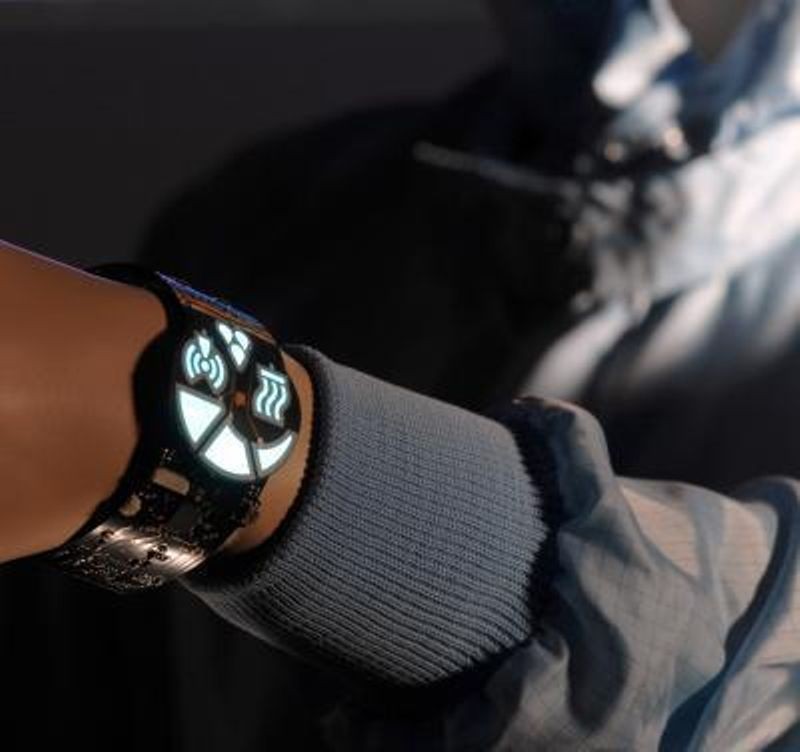
Advances in bio-monitoring and sensor technologies have made wrist-worn medical devices like the Sensory wristwatch possible.
A flood of smartwatches began to appear in 2011. The WIMM One, based on the Android operating system, could interact with smartphones via Bluetooth, allowing it to display incoming call phone numbers, as well as text messages. MetaWatch Strata, the Sony Erichsen LiveView, and the Samsung Galaxy Gear all came to market between 2011 and 2013. The crowd-funded Pebble watch was introduced in 2013 and was eventually carried at Best Buy electronics shops. The first order was sold-out in less than a week! These devices found popularity with engineers and early adopters of technology.
The wristwatch as a general form has been on the decline for more than a decade, at least partly due to the rise of cell phones as timepieces. Other smart watches found some success, but none broke through enough to lead to a mainstream resurgence of the form. AppleWatch has created a great deal of excitement in an area which many thought was no longer viable. If the AppleWatch is a success, perhaps the vision of so many science fiction authors will finally come true and everyone will wear a digital computer on their wrist. Beam me up Scotty!